How to Make Your Baby Sleep: Mystery Solved!
Baby sleep is one topic that has some parents baffled.
Your heart is filled with affection when you watch your infant slumbering. They look so sweet and innocent. But your heart may also race when you can’t get them to sleep when you genuinely need them to rest.
Does your little one take too much effort to go to sleep? Well, you can’t compel your baby to nod off at your order, there are a few things that mellow the bed.
Know the Facts and Understand Your Baby’s Sleep Needs
You can facilitate your anxiety and better plan to set your child’s sleep plan by understanding which parts of their sleep and nap routines are in your grasp – and which aren’t.
Newborn Baby Sleep Patterns
Infants may rest from 10 to 18 hours each day, usually for 3 to 4 hours constant. Babies don’t have the foggiest idea regarding the differentiation among day and night. Thus, they set down with no regard for what time it is. That suggests your baby’s wide-conscious time can be any time of day or night.
Aged 3 to 6 Months of Sleep Patterns
By 3 to 6 months, most of the children can rest for a stretch of 6 hours.
Aged 6 to 9 Months of Sleep Patterns
As your baby arrives at the age of 6 to 9 months, they begin getting into a routine, yet formative stages can confuse things again for the infant’s rest.
For instance, when your baby begins to connect sleep time with being distant from everyone else, she may start crying just to keep you around. This issue can be resolved by taking shifts to stay with your baby in cooperation with your accomplice.
5 Top tips to put your baby to sleep
“The key is to reduce incitement and flagging the body that it’s time to rest!”
We have put together our top five secrets to help you put an end to bedtime time battle and struggles with your babies and toddlers. Read on to find your baby’s Inner Sleep God/Goddess. The best part? You will be able to do this all without hollering, undermining or stressing your baby or yourself.
Excited? Let’s get started!
1. Massage Your Baby
Massage may assist your baby with dozing as a part of her sleep time routine. Studies recommend that massaging your child routinely may support with getting her circadian rhythms on target, which means she’ll rest more around night-time and be more active during the day. Sound perfect, right?

2. Make Nap and Bedtime Routines
The ideal approach to get your baby to sleep is to build up a wake-sleep timetable and stick to it.
Nothing works better than keeping kids on a schedule. It’s not generally conceivable with endless demands on today’s parents— and life can toss curves — yet keep nap and night sleep times as consistent as you can.
Your child can envision rest time by the standard you’ve made for them, so having a predictable nap time and sleep time routine will help the baby with snoozing off speedier.
In the event that your infant consistently makes it hard to nod off around night-time, you may have to change their nap plan. Step by step moving morning and evening naps earlier will help her sleep better and longer at night.
3. Use White noise
Nobody wants to miss a party, so if your infant is tuning in to all the fun going on in the house, it very well may be difficult to nod off and stay asleep.
White noise makes a harmonious, womb-like environment that quiets anxious newborns, urging them to settle and nod off quicker. White noise marvels with fussy children and is an incredibly ground-breaking prompt to help infant rest. The best white noise sleeping imitates the sounds babies hear in the womb.
4. Swaddle the baby
For the initial few months of life, your baby’s sensory framework is developing, and they can get overstimulated easily as they get introduced to uproarious clamours, bright lights, and intense aromas.
With this external stimulus, your newborn has a Moro reflex that may kick in, and this can cause them to feel fomented and more alert – as your infant’s arms and legs abruptly thrash outwards.
This is where swaddling comes in– being snuggly wrapped by a delicate fabric shields your child from awakening himself with unconstrained developments and, hence, assists with increasing a regular sleep pattern in longer-term also.
5. Differentiate between day and night
Lights push your baby’s natural ‘go’ button. On the other side, darkness triggers the mind to deliver melatonin, an essential rest hormone. Keep your infant’s days bright and his evenings dim, and he’ll rapidly sort out when it’s an ideal time to sleep.
During the day, allow a lot of daylight into the house or take him outside. Put your child down for daytime rests in a sufficiently bright room.
To prompt night drowsiness, think about introducing dimmers on the lights in your child’s room. Lower the lights at night (minimum two hours before sleep time) to set the mind-set.
Things you should try not to do to put your baby to sleep
There are many ways to get your baby to settle down for sleep. But here are three things you should try not to do:
- not letting baby sleep the entire day to rest longer at night-time.
- constant patting or rocking as baby needs to learn how to self settle.
- falling asleep while holding your baby.
Give it Time and Don’t Rush in!
Sorting out a way to make your baby sleep is a learning cycle. Your child will frequently complain and cry as a part of this learning process. Brief intervals of crying help newborns with sorting out some way to settle down, fall asleep, and pro the ability to doze.
Some babies make it harder than others to fall asleep. Finding the ideal approach to make your infant rest is a series of experimentation. Follow a reliable schedule and use calming methods to make baby sleep quicker. Be versatile and responsive to your baby’s evolving needs, and don’t overthink it, you got it… MAMA!







